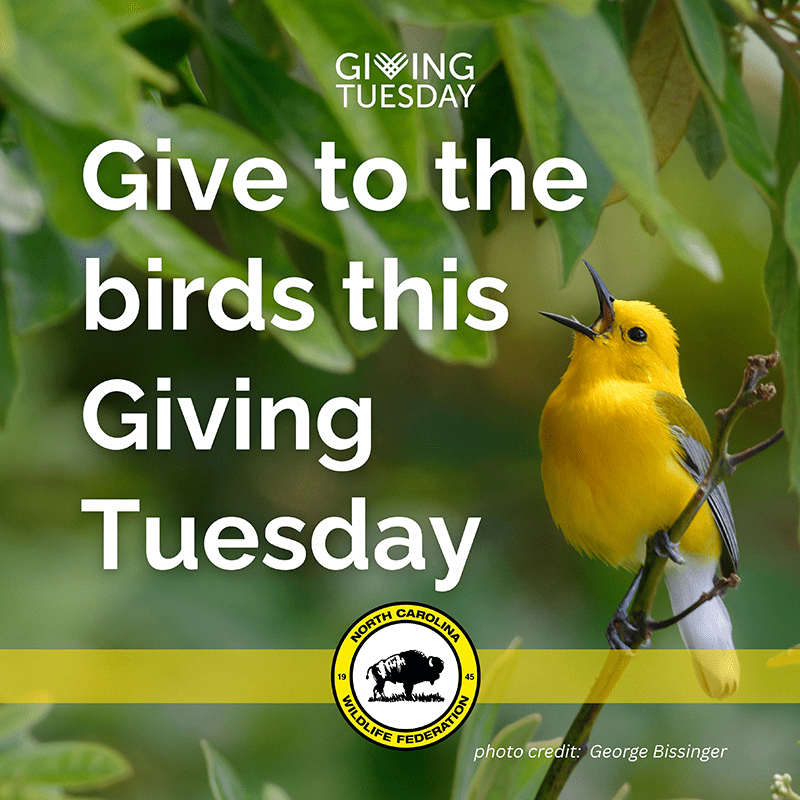Thanks to Our Volunteers! – May 2025 Community Wildlife Chapter Updates
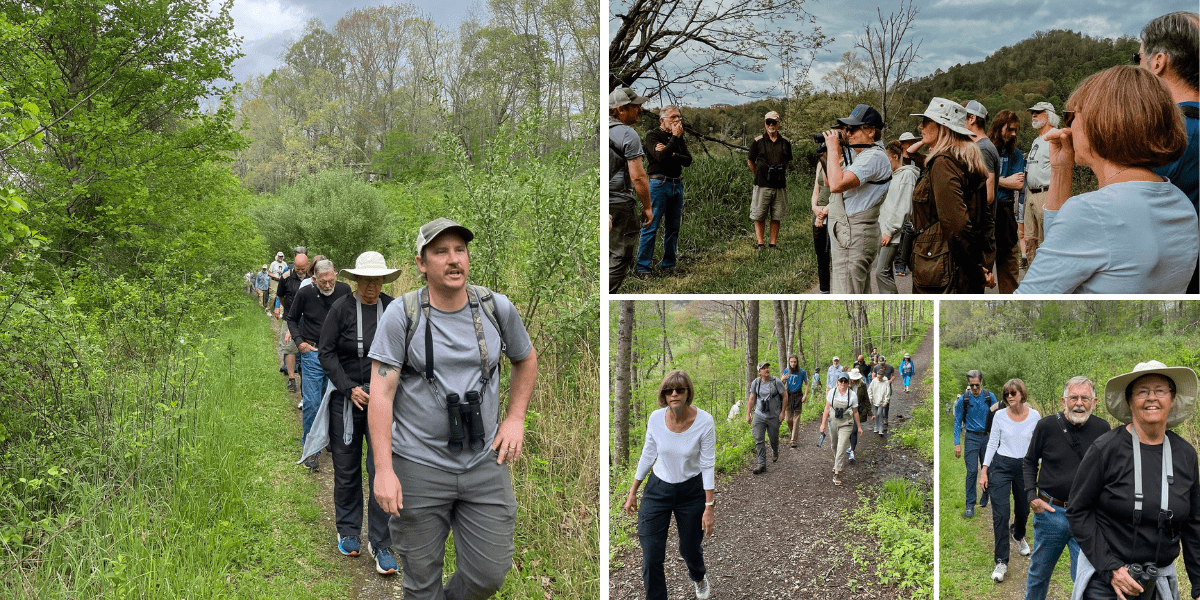
North Carolina Wildlife Federation staff and Community Wildlife Chapter volunteers were in full swing throughout the month of April, they connected people to the outdoors via paddles and outings, native tree and pollinator plant planting, litter pickups, and invasive species removals. In May, 1,010 people were given the opportunity to connect with nature through one of NCWF’s 48 events! (That’s more than there are days in the month!) This month from the mountains to the sea, 4,468 lbs of litter were removed from the landscape and 815 native pollinator plants were sowed in the ground by NCWF Community Wildlife Chapters and partners.
Thanks to partners such as the Duke Energy Foundation, Jandy Ammons Foundation, and Burt’s Bees for helping make these habitat restoration workdays, educational programs and nature outings possible. Explore our Events Calendar to discover where NCWF and our Community Wildlife Chapters are hosting in-person and virtual events near you. Check out a few highlights below from our conservation outreach team.
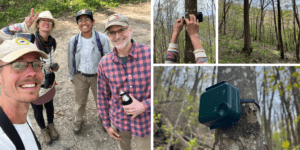
May 1, Cerulean Warbler & Avian Diversity Study: The North Carolina Wildlife Federation led volunteers in the field to monitor and record cerulean warblers within Craggy Mountains – Pisgah National Forest where the presence of ceruleans and many other avian species is largely unknown. The survey is a collaborative effort between the North Carolina Wildlife Federation, National Parks Conservation Association, the Center for Biological Diversity, Defenders of Wildlife, MountainTrue, and the N.C. Wildlife Resources Commission with support from the U.S. Forest Service.
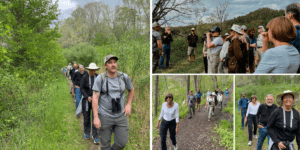
May 4, High Country Wild Kick-Off Event: NCWF newly forming chapter, High Country Wild hosted their inaugural event in Boone. The group started the day with a nature walk through wetland and meadow habitat along the South Fork of the New River. Afterwards, everyone gathered for drinks and fellowship at Booneshine Brewery.

May 6, Guided Frog Walk: The NCWF Habitat and Wildlife Keepers (HAWK) chapter took off on Four Mile Creek Greenway in Charlotte with chief naturalist and Frogologist Taylor Piephoff. A group of 30 hit the greenway at sunset, hoping to hear and see native frogs and other critters. The evening was fruitful with sightings of cricket frogs, green frogs, and even a bullfrog. Participants learned to identify the calls of gray tree frogs and leopard frogs along the way.
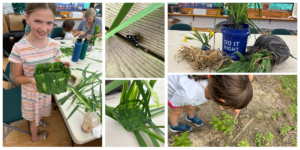
May 7, Iris Basketry with Pocosin Arts: NCWF, Pocosin Lakes NWR, and Pocosin Arts School of Fine Craft teamed up for an iris basketry class! Participants of all ages learned the art of basket weaving using both dried and freshly pulled iris leaves. As part of a larger habitat restoration project at the Pocosin Lakes NWR Visitor Center, Columbia High School students and community volunteers helped remove the invasive yellow-flag irises that were used for this program!
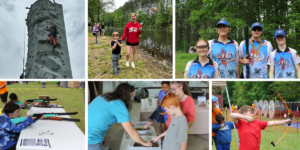
May 10, Youth Day: NCWF Gaston PAWS chapter and Gaston County Ducks Unlimited held a wonderfully successful event at Wood Duck Farm in Gastonia! More than 475 folks attended the 2nd Annual Family Feathers and Fun Youth Day. This event was made possible with the help of 50 volunteers from the community. Children and youth participated in rock climbing, disc golf, skeet shooting, and fishing. Over 317 kids were fed during this FREE event!
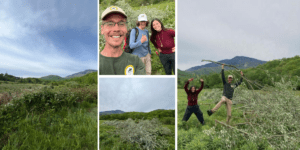
May 10, Bowditch Bottoms Invasive Species Removal: The North Carolina Wildlife Federation in partnership with Southern Appalachian Highlands Conservancy hosted a trash clean-up and invasive species removal at Bowditch Bottoms (SAHC owned site) in Yancey County. Bowditch Bottoms contains mixed hardwood forest, cleared agricultural fields, valuable wetland habitat within the South Toe River Watershed, and a riparian area that buffers over a half mile of Ayles Creek. Over 4 thousand pounds of trash and debris brought in from Helene was removed from the site. The crew removed invasive species – primarily multiflora rose and autumn olive that are established within the site’s wetland areas.
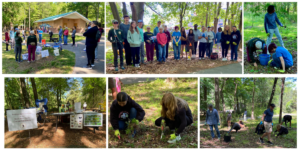
May 10, NRHC Invasive Removal at Main Street Park: NCWF Neuse River Hawks Conservationists Chapter participated in an invasive plant removal at Main Street Park in Rolesville. Volunteers helped remove Japanese stiltgrass, privet, and autumn olive from a large section of forest behind the park’s playground. Students from local middle and high schools really showed up for this event, and they learned a lot about how to identify different types of invasive plants.
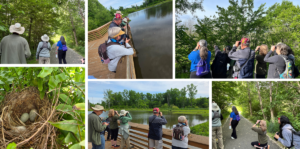
May 10, Guided Bird Walk: The Concord Wildlife Alliance and Mecklenburg Audubon’s Judy Walker led a group of 13 wildlife enthusiasts on a bird walk along the Moss Creek section of the Hector Henry Greenway in Concord. Sightings included a barred owl, an indigo bunting, and a prothonotary warbler!
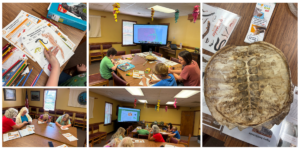
May 13, Herpetology Basics with ecoEXPLORE: NCWF, Pocosin Lakes NWR, and Tyrrell County Library partnered for an ecoEXPLORE event all about herpetology. ecoEXPLORErs had the opportunity to ask all of their herp questions and completed a salamander adaptation activity to help them earn points for this season’s badges.
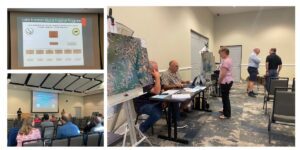
May 14, LNWC Island Habitat Adoption: The Island Habitat Program (IHP), managed by the NCWF Lake Norman Wildlife Conservationists (LNWC) chapter, enhances island habitats for wildlife on Lake Norman through volunteer efforts like native plantings and shoreline restoration, litter sweeps, and bird nest box installations. Wildlife and lake enthusiasts interested in adopting an island were invited to join NCWF and LNWC for a kick-off event at the Charles Mack Conference Center in Mooresville. We familiarized interested adopters with the IHP and sought individuals or groups of individuals to adopt islands and perform routine clean-ups and inspections, including habitat enhancement projects and wildlife monitoring.

May 15, Native Planting at the Friends School of Wilmington: Middle and elementary school students helped plant 85 native pollinator plants around the Chimney Swift tower at the Friends School to attract plenty of insects for the birds to eat, funded by Duke Energy and WIN of New Hanover County.
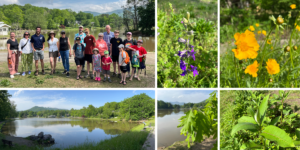
May 15, Lake Tomahawk Nature Walk: Swannanoa Valley WILD! went nature walking on a hot spring day at Lake Tomahawk in Black Mountain with Black Mountain Recreation. The chapter spotted all sorts of wildlife including nesting tree swallows, blooming lance-leaf coreopsis, buzzing carpenter bees, foraging squirrels, fluttering tiger swallowtails, and much more! During the walk, the chapter discussed upcoming chapter projects and events at the lake including tree plantings, invasive species removals, and wildlife garden installations.
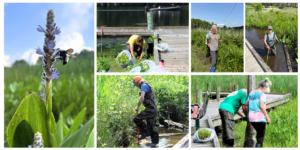
May 15, Pembroke Creek Park Community Planting: NCWF Wildlife Habitat Stewards of Northeastern NC Chapter and community volunteers planted over 700 native wetland plants at Pembroke Creek Park in Edenton, home to a variety of wildlife that will benefit from this habitat restoration project.

May 17, Stream Walk: The Union County Wildlife Chapter and City of Monroe Environmental Educator Ellen Dowling led folks on a stream walk and macroinvertebrate investigation. Folks got their hands dirty and feet wet searching for aquatic life in a local stream.
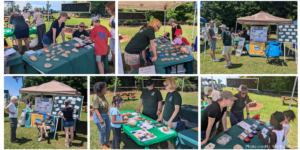
May 17, SWC Wild About Nature: NCWF South Wake Conservationists Chapter participated in Wild About Nature at Sugg Farm in Holly Springs. Chapter volunteers engaged children and their parents with interactive activities about red wolves, animal tracks, NCWF’s Save Our Sounds campaign, and North Carolina wildlife trivia.

May 18, Bat Box Installation at Wade Park: Three bat boxes were installed at Wade Park in Wilmington to complete an eagle scout project, funded by Duke Energy and WIN of New Hanover County.
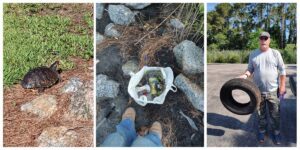
May 18, LCFW Monthly Cleanup: The LCFW chapter met at the Southport boat ramp and picked up 42.5 lbs of litter.
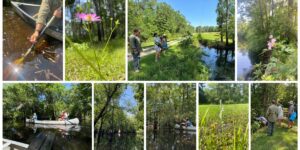
May 18, SSS Waccamaw River Leadership Paddle: The SSS chapter leaders paddled along the Waccamaw River to plan a route for future chapter events. They observed Swamp rose gentians, Swamp roses, Hawthorn trees, Bald cypress, Water oak, Spanish moss, Mosquito fish, Dragonflies, Damsel flies, and a lively chorus of songbirds including Yellow Warblers, Acadian Flycatchers, Red-eyed and Yellow-throated Vireos.
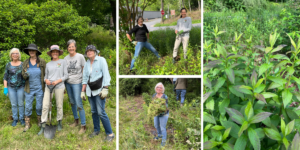
May 20, Lake Tomahawk Wildlife Garden Workday: Swannanoa Valley WILD! hosted an event at Lake Tomahawk in Black Mountain to kick off the chapter’s wildlife garden project. The volunteer crew was not phased by the non-native invasive plants running rampant through the garden. Instead, they rolled up our sleeves and got to work. Pulling, digging, sweating, and laughing along the way. The volunteers removed bedstraw, common vetch, multiflora rose, orchard grass, and much more. The chapter’s long-term goal is to transform the space into habitat for wildlife. A garden rich with native plant species, pollinators, mammals, birds, and maybe even a snake or two
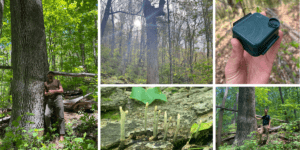
May 22, Cerulean Warbler & Avian Diversity Study: The North Carolina Wildlife Federation led volunteers in the field to monitor and record cerulean warblers within Craggy Mountains – Pisgah National Forest where the presence of ceruleans and many other avian species is largely unknown. The survey is a collaborative effort between the North Carolina Wildlife Federation, National Parks Conservation Association, the Center for Biological Diversity, Defenders of Wildlife, MountainTrue, and the N.C. Wildlife Resources Commission with support from the U.S. Forest Service.

May 23, Butterflies and Native Plants: Partners in Pollination: NCWF Wildlife Habitat Stewards of Northeastern NC Chapter provided an engaging presentation on butterflies and native plants at the Camden County Public Library where participants learned about best host plants to support butterflies. Folks received information on how they can create their own pollinator pitstops at home as part of the Butterfly Highway program and left the with milkweed plants to help kickstart their pollinator habitats.
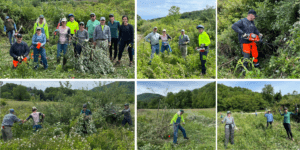
May 23, Bowditch Bottoms Invasive Removal: The North Carolina Wildlife Federation in partnership with Southern Appalachian Highlands Conservancy hosted an invasive species removal at Bowditch Bottoms (SAHC owned site) in Yancey County. Bowditch Bottoms contains mixed hardwood forest, cleared agricultural fields, valuable wetland habitat within the South Toe River Watershed, and a riparian area that buffers over a half mile of Ayles Creek. The crew removed invasive species – primarily multiflora rose and autumn olive that are established within the site’s wetland areas. In the fall 2025 and into next year, we plan to replace the removed non-native invasives with native plant species.

May 23, NRHC Invasive Removal at Main Street Park: NCWF Neuse River Hawks Conservationists Chapter hosted an invasive plant removal at Main Street Park in Rolesville. Volunteers helped remove Japanese stiltgrass, privet, and Chinese holly from a large section of forest behind the park’s playground.

May 24, SWC Trash Cleanup at Walnut Creek Wetland Park: NCWF South Wake Conservationists Chapter held a Clean and Green Trash Cleanup at Walnut Creek Wetland Park in Raleigh. Volunteers helped remove 200 pounds of trash from the chapter’s adopted wetland area, protecting wildlife from ingesting or getting tangled in trash, and keeping microplastics out of our waterways.
Written by:

– Page Turner, Conservation Coordinator

– Laura Frazier, Refuge Conservation Coordinator

– Natalie Bohorquez, VP of Conservation Partnerships
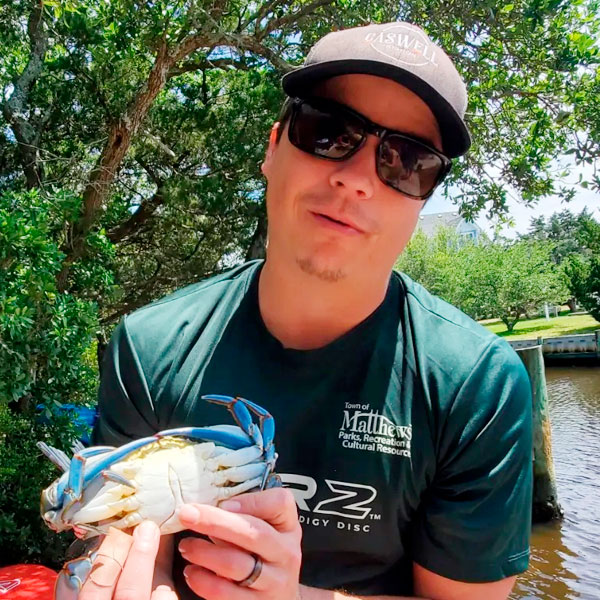
– Alden Picard, Conservation Coordinator

– Kara Solomon, Conservation Coordinator

– Luke Bennett, NCWF Conservation Coordinator


